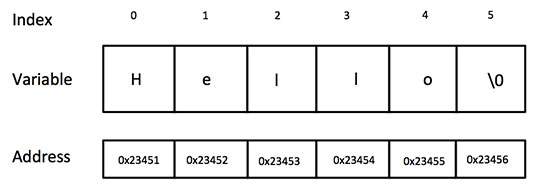字符串
C++ 提供了以下两种类型的字符串表示形式:
- C 样式字符串
- 用标准 C++ 介绍的标准字符串类型
C 样式字符串
C 样式字符串源于 C 语言,在 C++ 中仍然被支持。这个串实际是一个字符的一维数组,这个数组以一个空字符 ‘\0’ 结束。因此以 null 结尾的字符串包含由字符组成的字符串,此字符串后跟着一个 null。
接下来声明和初始化创建一个字符串,这个字符串组成一个单词 "hello"。为了包含数组末尾的空字符,包含该字符串的字符数组的大小应该比单词 "hello" 中的字符的数目多一个。
char greeting[6] = {'H', 'e', 'l', 'l', 'o', '\0'};如果你遵循数组初始化的规则,你可以像下面一样书写上面的语句:
char greeting[] = "Hello";以下是在 C/C++ 中定义上面的字符串的内存演示:

实际上,你不需要在字符串常量的末尾放置一个空字符。 C++ 编译器在初始化数组时自动在串的末尾放置一个 '\0'。让我们尝试打印上述字符串:
#include <iostream>
using namespace std;
int main ()
{
char greeting[6] = {'H', 'e', 'l', 'l', 'o', '\0'};
cout << "Greeting message: ";
cout << greeting << endl;
return 0;
}当上述代码被编译执行时,它将产生如下结果:
Greeting message: HelloC++ 支持广泛的函数来操作以空字符终止的字符串:
| SN | 函数和功能 |
|---|---|
| 1 | strcpy(s1,s2); 将字符串 s2 复制到字符串 s1 中。 |
| 2 | strcat(s1,s2); 将字符串 s2 串联到字符串 s1 的结尾。 |
| 3 | strlen(s1); 返回字符串 s1 的长度。 |
| 4 |
strcmp(s1,s2);
如果 s1 和 s2 相同,返回 0;如果 s1≥s2,返回大于 0 的数;如果 s1 |
| 5 | strchr(s1,ch); 返回在字符串 s1 中指向第一次出现字符 ch 的指针。 |
| 6 | strstr(s1,s2); 返回在字符串 s1 中指向第一次出现字符串 s2 的指针。 |
以下是应用了一些上述函数的示例:
#include <iostream>
#include <cstring>
using namespace std;
int main ()
{
char str1[10] = "Hello";
char str2[10] = "World";
char str3[10];
int len ;
// copy str1 into str3
strcpy( str3, str1);
cout << "strcpy( str3, str1) : " << str3 << endl;
// concatenates str1 and str2
strcat( str1, str2);
cout << "strcat( str1, str2): " << str1 << endl;
// total lenghth of str1 after concatenation
len = strlen(str1);
cout << "strlen(str1) : " << len << endl;
return 0;
}当上述代码被编译执行时,它将产生如下结果:
strcpy( str3, str1) : Hello
strcat( str1, str2): HelloWorld
strlen(str1) : 10C++ 中的字符串类
标准的 C++ 库中提供了一个 string 类,它支持上面提到的所有的操作,另外它还有更多的功能。我们会研究 C++ 标准库中的这个类,但现在我们先检查以下示例:
在这点上,你可能还没有明白这个例子,因为到目前为止我们还没有讨论类和对象。所以直到你理解了面向对象的概念你才可以继续进行下去。
#include <iostream>
#include <string>
using namespace std;
int main ()
{
string str1 = "Hello";
string str2 = "World";
string str3;
int len ;
// copy str1 into str3
str3 = str1;
cout << "str3 : " << str3 << endl;
// concatenates str1 and str2
str3 = str1 + str2;
cout << "str1 + str2 : " << str3 << endl;
// total lenghth of str3 after concatenation
len = str3.size();
cout << "str3.size() : " << len << endl;
return 0;
}当上述代码被编译执行时,它将产生如下结果:
str3 : Hello
str1 + str2 : HelloWorld
str3.size() : 10